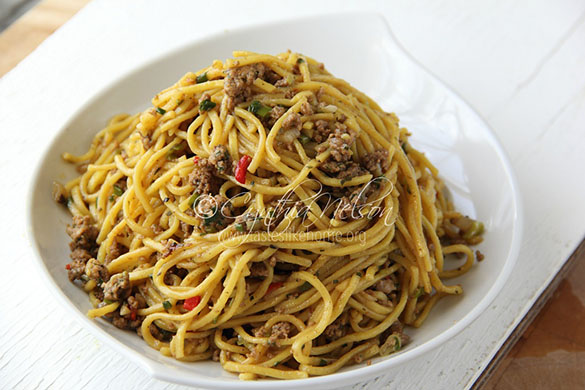
Noodles
We are fortunate in the region to be able to access a variety of locally and regionally made Chow Mein noodles and most of them are made with flour and water along with food colouring to give a signature look. Each manufacturer has their own specifications for making the noodles in terms of the thickness or thinness and the hue of yellow. All of our Chow Mein noodles are sold dry in packages ranging from one pound to 8 ounces and less. In terms of which noodles cook up best, I would recommend that you go with those that yield the kind of results you want and what you are looking for in Chow Mein. I tend to opt for noodles that are thicker or broader rather than the very fine noodles; I like the mouth feel and texture.
Another thing I look for in Chow Mein noodles are those that are a little springy when cooked, it tells me that the dough was well kneaded and perhaps made with water containing a specific pH balance. If available, I also purchase Chow Mein noodles made with eggs because of the texture and flavour when cooked.
When cooking the noodles, bring a large pot of salted water to a roaring boil and add the noodles. It is not necessary or recommended that you break up the noodles; doing so would release starch into the water and can make things rather pasty. Another important thing to do when cooking the noodles is to remove them from the heat about 2 minutes shy of them being finished, so that by the time they are is stir-fried with the other ingredients, cooking is complete.
Unlike the cooking of pasta, Chow Mein noodles should be rinsed thoroughly under cool tap water to stop the cooking process, remove the excess starch and drained well. With pasta, you want the starch to remain on the noodles so that the sauce can adhere to it; not so with Chow Mein. With Chow Mein, you are making a stir fry with other ingredients. Different technique and dish altogether.
Vegetables and meat
There really are no rules about how the vegetables or meat should be cut to make Chow Mein. However, a logical approach would be to cut them in a manner that is similar to the main ingredient so that they can be easily tossed together and served. Therefore, try cutting the vegetables into thin long strips of 2 – 3 inches, carrots, bora, pak choi and cabbage, if using; even the scallions. For meats – chicken, beef, pork, cut them into thin long strips, this will also facilitate quick cooking.
Sauce or no sauce
We eat with our eyes and a lot people want there to be some type of sauce when making Chow Mein because they think it looks more appetizing and not dry. For me, Chow Mein in a stir fry and I like to see all the ingredients clearly. While there are stir fries that have sauce for seasoning and flavour, I cook Chow Mein with only just enough soy sauce to flavour the dish itself, not to add colour or moisture. The meat I usually season with dark and regular soy sauce and a little Oyster sauce; when cooked, the drippings are picked up by the veggies, ginger, garlic, hot pepper and noodles as everything gets tossed together. A couple splashes of soy sauce that are easily absorbed into the ingredients for seasoning and flavour is all the ‘sauce’ in my Chow Mein.
The pan
I must confess that I am spoiled for having a wok. Before getting a wok, I would use a trusted large karahi when making Fried Rice or Chow Mein but with my wok, the breath and space it provides makes it really easy to move around the ingredients. I don’t have to worry about the pan being too full or things not being mixed together properly; the wok gives me room. Please do not get me wrong, I am not saying to go out and buy a wok. I recommend that you use a pan that is wide, roomy with space, like a nice big karahi. You can always store the food in a more traditional pot when you’re done cooking.
What’s on the menu this weekend? Chow Mein?Cynthia
cynthia@tasteslikehome.org
